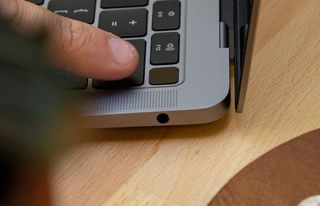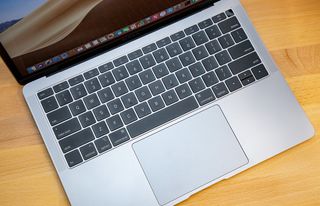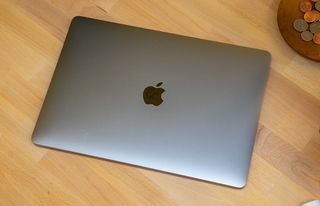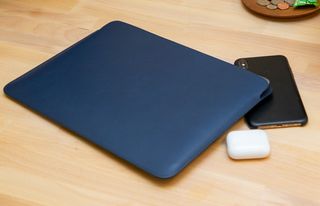Laptop Mag Verdict
The new MacBook Air is a welcome upgrade with a sharper display in a thinner and lighter design, but this laptop could use more power.
Pros
- +
Thin and light design
- +
Sharp Retina display
- +
Eco-friendly aluminum chassis
- +
Booming audio
- +
Thunderbolt 3 ports
- +
Touch ID without the Touch Bar
Cons
- -
Slower than competition
- -
Expensive starting price
- -
Display could be brighter
Why you can trust Laptop Mag
Editor's Note 7.19.21: Laptop Mag doesn't generally recommend laptops two years or older. If you're in the market for a new MacBook, please check out our reviews on the MacBook Pro 2020 (13-inch) and Apple MacBook Pro (13-inch, M1, 2020).
When Steve Jobs pulled the first MacBook Air out of a thin, manilla envelope in 2008, it started a revolution in laptop design that inspired 10 years of imitations. But in that decade, the MacBook Air stagnated while the rest of the market caught up and then surpassed Apple's iconic portable. And now, in 2018, the once-beloved MacBook Air is finally getting the feature it has needed most.
Yes, that high-res Retina screen that Apple gave the MacBook Pro in 2012 has finally arrived on the MacBook Air. That's just one of many changes, though: This new Air also gives users a Touch ID sensor for biometric security, superfast SSD storage, fantastic sound and dual Thunderbolt 3 ports. Apple's new device is also better for the environment, as the machine is made of 100 percent recycled aluminium.
The Air's overall performance may not stack up well against that of similar Windows laptops, but this might not matter as much for those firmly ensconced in macOS. The biggest issue is that the Air is pricier than ever (tested at $1,299/ £1,299, starting at $1,099/ £1,099). So, while the new MacBook Air may work for those who have been holding out, it might not meet the highest hopes and expectations.
If you're on the fence about which MacBook to buy, check out our MacBook vs MacBook Air vs MacBook Pro face-off.
Design
The curves of the new MacBook Air's lid and underside, as well as its display bezels, have been tapered down from previous years. This makes the MacBook Air look like a sibling -- and not a long-lost relative -- to the MacBook Pro and 12-inch MacBook (which you'd be crazy to buy now).

The Air's iconic wedge design is intact, helping the machine stand out from those other laptops. While the Air is sold in traditional silver and a new gold hue, the model we tested is a Space Gray that looks quite attractive.

Apple's making these new MacBook Airs out of its own 100 percent recycled aluminum, but you couldn't tell from using the device. This machined metal looks and feels just like the same material that Apple's used for previous MacBooks.
Weighing 2.7 pounds and measuring 0.6 inches thick, the MacBook Air's slightly lighter than my favorite MacBook copycat, the Huawei MateBook X Pro (2.9 pounds, 0.6 inches). The new Air is similar in size to the Microsoft Surface Laptop 2 (2.7 pounds, 0.6 inches) and the Dell XPS 13 (2.7 pounds, 0.5 inches), but the HP Spectre 13 (2.4 pounds, 0.4 inches) is both lighter and thinner than Apple's machine.
Ports
The MacBook Air sports two speedy Thunderbolt 3 ports (which enable much faster data-transfer speeds) on its left side, with a headphone jack on its right. That might be an upgrade from the MacBook's singular, slower USB Type-C port, but it's lacking in comparison to most competitors.

The Spectre 13 matches the Air's selection and throws an additional USB Type-C port on top. The XPS 13 also offers dual Thunderbolt 3 ports and adds a microSD reader and a USB Type-C port. The Surface Laptop 2 is laughably bad on ports, with one Type-A USB 3.0 port and a Mini DisplayPort.

Arguably the best set of ports comes from the MateBook X Pro, which I wanted Apple to imitate. Huawei's laptop packs two reversible Type-C ports (only one is a Thunderbolt 3), a headphone jack and one of those familiar, boxy, Type-A USB 3.0 ports. You know, the port that practically every accessory and cable today is made for, which forces you to pay up for an adapter if your laptop doesn't have it.
Touch ID and T2 Chip
In the top right corner of the keyboard, you'll see a Touch ID fingerprint reader, which I found works great for unlocking the MacBook Air and signing into 1Password, my preferred password manager. Thankfully, Apple's giving users the power of this biometric sensor without burdening them with the Touch Bar that accompanies Touch ID on the company's MacBook Pros.

On top of sporting Touch ID, this is the first MacBook Air with the T2 security chip that Apple's adding to as many macOS machines as it can (including the Mac mini). Not only does this chip provide Apple's Secure Enclave technology for storing the fingerprints used in Touch ID, but it also enables "on-the-fly data encryption," so your SSD's data is encrypted by default. This chip also allows for touch-free "Hey, Siri" activation, which worked well when I checked the weather.
How much does the MacBook Air cost? Pricing and configurations
Starting at $1,099 (formerly $1,199, the price was changed on July 9), the MacBook Air ain't cheap. It also sells at a notable price hike from the previous-gen Air, which started at $999.
MORE: The New MacBook Air Has a Looming Reliability Issue
What do you get for that $1,099? Apple's starting configuration packs 8GB of RAM, 128GB of SSD storage and a Core i5-8210Y processor. To get the model we tested, you'll spend an extra $200 for a bump up to 256GB of storage, which is the minimum amount of local storage I'd recommend.
Display
The 2560 x 1600-pixel Retina display is the true star of the new MacBook Air, offering crisp detail and solid colors. As I watched the first episode of The Chilling Adventures of Sabrina, I noted rich reds in her jacket, lush green foliage in a creepy forest and vibrant pink neon at a movie theater. The July 2019 update to the MacBook Air added a True Tone display that adapts to ambiet lighting, which we've seen in the 2019 13-inch MacBook Pro as well this year's 15-inch MacBook Pro.

Inky black spiders in the opening credits looked so dark that I wondered for a second if this notebook was using an OLED display (it's not). As I watched a 4K video of the Colorado Rockies and a nearby pond, I noted tons of detail, including tiny ripples in the water and small, sharp, jagged rocks at the tops of the summits.
The 2560 x 1600-pixel Retina display is the true star of the new MacBook Air, offering crisp detail and solid colors.
In terms of color output, our colorimeter rates the MacBook Air's panel at 109 percent of the sRGB gamut, a mark slightly shy of the 116 premium notebook average (laptops $800 and up) and close to the Spectre 13's 111 percent. We saw higher ratings from the XPS 13 (130 percent at 1080p, 117 percent at 4K), the Surface Laptop 2 (176 percent) and the MateBook X Pro (124). The HP Spectre 13 hit a similar 111 percent.
While Apple rates the Air's panel as capable of producing 300 nits of brightness, our unit maxed out at 234 nits, which is close to the 247-nit Spectre 13 and less than the 317-nit premium-notebook average. We found brighter screens in the XPS 13 (372 nits at 1080p, 415 nits at 4K), the Surface Laptop 2 (321 nits) and the MateBook X Pro (458).
MORE: Apple MacBook Air vs. Dell XPS 13: Which Should You Buy?
As I tested the MacBook Air, I felt that the display was bright enough, especially as I watched a nature video, with trees and lakes retaining their vibrancy when I rotated the screen 30 degrees. Annoyingly, though, those same colors darkened a tad at 45 degrees to the left and right. The Surface Laptop 2, MateBook X Pro and XPS 13 are all so bright that they don't have issues with viewing angles.
Keyboard and Touchpad
I've never been a fan of the butterfly-switch keys that Apple uses, but I'm starting to accept them. On the 10fastfingers typing test, I clicked to a rate of 76 words per minute, with about 97 percent accuracy. This is owed to the keys' 70 grams of required actuation force (we look for at least 60 grams) not their measly 0.6 millimeters of travel (1.5 to 2.0 is preferred).

I wrote a lot of this review on the MacBook Air, but when I had to put the machine down for testing, I continued the review on my aging 2015-style MacBook Pro. And when I did, I was reminded about why I'm reluctant to quit using that old laptop. Sure, butterfly-style keys are thinner, giving Apple more space for the battery and the ability to make a thinner laptop, but they don't feel as comfortable to type on. Apple's older keys have much greater amount of vertical travel.

But what do current MacBook Air owners think? I handed the new Air to my mom, who's used a MacBook Air for over six years. Her verdict was simple: "I think I like this keyboard: I have no problems with it." Not high praise but a solid vote of confidence in Apple, nonetheless. I'm personally a little uneasy about the butterfly switch's long-term durability, and I will be switching to use this Air full time to see how its keyboard holds up.
I've never been a fan of the butterfly-switch keys that Apple uses, but I'm starting to accept them.
Apple's also changed the MacBook Air's touchpad, moving from a traditional clickable surface to the all-glass Force Touch trackpad. This 4.6 x 3.1-inch surface provided accurate input recognition and smooth scrolling. The bigger difference is that the Force Touch nature of the trackpad means that Apple's giving you the illusion that the touchpad is moving, via haptic feedback.
Audio
This MacBook Air produces some really solid sound. As the laptop filled our large newsroom with the sweet melodies of Carly Rae Jepsen's "Party for One," I noted the song's strong bass, clear vocals and crisp drum cymbals.
Don't worry if pop music isn't your vibe. The hard post-punk rock of Idles' "Colossus" sounded excellent on the Air, particularly the tune's growling guitar riffs. Apple touts this Air as offering twice as much bass and 25 percent more volume compared to the 2017 MacBook Pro, and having used both, I believe those claims.
Performance
When I discovered that this MacBook Air runs on an Intel Core i5-8210Y processor, blaring sirens went off in my head. Y-series processors are known for offering less-than-premium performance, as was found in the decidedly meh 12-inch MacBook. Yes, the Air may not be Apple's Pro-grade laptop, but with its $1,099 starting price (which includes 8GB of RAM), it's a premium-level product.

So, I went about testing this machine with a strong eye toward its performance, both on synthetic tests and in everyday use, to see if I could rely on it as my everyday work machine. I'm not editing movies or dealing with heavy Photoshop files, but can this machine live up to the standards that journalists have relied upon? (The MacBook Air spent many years being the laptop seen in the hands of writers at press events.)
I think the answer is yes, fortunately enough. I saw minimal pauses as I moved between apps and web pages after I'd opened 17 Safari tabs, five Chrome tabs (including the Google doc for this article, a YouTube video and Netflix), iTunes, Messages, Photos (syncing my 80,000+ iCloud Photo Library) and Mail. The MacBook Air stayed responsive as I loaded TweetDeck, Pixelmator and Bear, three of the other apps I use more than any other on my Mac.
Then, I used Continuity Camera -- one of macOS Mojave's best new features -- to easily drop a photo into a new email, and I chuckled as it all happened without a pause, even with all that stuff open in the background. That much multitasking gives me confidence in the MacBook Air, which every journalist needs with their hardware. The one downside was that the fans on the Air had spun up pretty loud when I was doing all of that, but they quieted down when I stopped moving between apps so quickly and stuck with Chrome, Pixelmator and Messages.
I used Continuity Camera to easily drop a new photo into a new email, and I chuckled as it all happened without a pause, even with tons of apps open in the background.
My why-oh-Y-series concerns reared their head when the MacBook Air notched a 7,871 on the Geekbench 4.3 general performance benchmark, achieving about two-thirds of the 12,230 category average.
We saw higher scores from similarly priced PC laptops that sported faster U-series processors, including the Core i5-8250U-based XPS 13 9370 (13,254), the Core i7-8550U-based Spectre 13 (13,090), the Core i5-8250U-based Surface Laptop 2 (12,744) and the Core i7-8550U-based MateBook X Pro (13,769). All of these PCs were tested with 8GB of RAM, except the MateBook X Pro, which had 16GB of memory.

The MacBook Air looks to make up for that performance weakness with amazing SSD performance, as the Blackmagic disk test clocked the write speeds on the Air's 256GB SSD at a blistering 2.1 gigabytes per second. To put that in perspective, the category average for premium laptops is 500.1 megabytes per second. The SSDs in the XPS 13, HP Spectre 13, Surface Laptop 2 and MateBook X Pro all performed at rates from 203 to 508 MBps, which is a fraction of what Apple's laptop pulled off.
The MacBook Air took a long time of 3 minutes and 26 seconds to complete our Excel VLookup test (which matches 60,000 names to addresses), a time more than twice as long as the 1:34 category average. The XPS 13 (1:08), Surface Laptop 2 (1:15) and MateBook X Pro (1:49) all turned in faster run times.
MORE:MacBook Air: Can Apple Stage a Comeback?
The MacBook Air also stumbled on our HandBrake video-conversion test, taking 37:24 to transcode a 4K video to 1080p -- 50 percent longer than the 21:08 premium laptop average. The XPS 13 (18:17), Surface Laptop 2 (17:30) and MateBook X Pro (27:18) each took less time.
On November 8, the day after the MacBook Air's Nov. 7 release, Apple issued the macOS Mojave 10.14.1 Supplemental Update for MacBook Air (2018). Don't confuse this with the previously-issued macOS 10.14.1 update, this patch aims to "improve the stability and reliability of MacBook Air (2018) computers, and is recommended for all users." Find out more, including our instructions for how to download this update, here.
Graphics
Apple's checkered history with graphics performance continues with the Air, which features the Intel UHD Graphics 617 integrated chip. The Air ran the OpenGL portion of the Cinebench R15 benchmark, which measures graphics performance, at 35.3 frames per second, which is well behind the XPS 13's 49.3 fps (Intel UHD Graphics 620).

The Air struggled with the modestly demanding racing game Dirt 3 (set to medium graphics at 1080p), which the machine ran at 21.5 frames per second. That falls below our smoothness threshold of 30 fps and far under the 71 fps premium notebook average.
We saw faster rates from the XPS 13 (57 fps), Spectre 13 (57 fps), Surface Laptop 2 (82 fps) and MateBook X Pro (117). All of those competitors feature the Intel UHD 620 chip, except for the MateBook, which owes its speed to the 2GB Nvidia MX150 GPU.
Battery Life
Historically, the MacBook Air is loved for its long battery life. This year's model lasted a solid 9 hours and 32 minutes on the Laptop Mag Battery Test (web surfing at 150 nits) -- beating the 8:09 premium notebook average. However, that run time is below the "up to 12 hours of wireless web" that Apple touts and less than the 9:55 time from the MateBook X Pro.
The new MacBook Air lasted a solid 9 hours and 32 minutes on our battery test.
XPS 13 owners get more life with a 1080p screen (11:59) and shorter life with a 4K display (8:23). The Spectre 13 (5:16) lasts less time, and the Surface Laptop 2 (9:22) was slightly behind the MacBook Air.
Webcam
Prospective MacBook Air owners should expect grainy but functionally acceptable image quality from the laptop's 0.7-megapixel webcam. The selfie I shot in Photo Booth provides correct colors for my blue knit cap, my dark gray shirt and the green bar behind me, but the image itself is quite soft, and far from crisp.
I'd still take this camera over those of the Air's competitors, as the webcam is placed in the middle of the top bezel. You might think that's unimportant, but the XPS 13 and MateBook X Pro feature cameras in the bottom bezel of their screen and keyboard (respectively), so they're facing you from beneath, making for awkwardly angled photos.
Heat
Apple's 100 percent recycled aluminum chassis gets warm, but not too hot. After we streamed 15 minutes of full-HD video on the Air, our heat gun captured temperatures on the laptop's touchpad (84.5 degrees Fahrenheit), keyboard (91.5 degrees) and underside (93 degrees) that stayed below our 95 degree comfort threshold. The Air may be a bit warm if you hold it at the spot by its hinge after some serious work, as that specific location came in at 96 degrees.
Software (Catalina Coming Soon) and Warranty
While I wasn't wowed by macOS Mojave, it's been a seamless update ever since I installed it back on launch week. And even though I was most excited for Dark Mode, its new Continuity Camera feature-- where you snap photos with your iPhone camera that are pasted into your Mac apps -- makes a great case for living in the Apple ecosystem, where your devices work seamlessly.

Also, the Stacks view in Finder is proving as helpful as having a butler to manage my messy desktop. It's features like this, plus my preference for macOS over Windows, and the third-party apps exclusive to the Mac, that repeatedly have me (and others) willing to pay what PC users call the Apple Tax.
Wondering about the future of macOS? macOS Catalina has now entered Public Beta, and will eventually bring iPad apps to the Mac when it launches this fall. Check out our macOS Catalina Public Beta review, which splits iTunes into three apps. Ready for risk? We've got instructions to help you install the macOS Catalina public beta for yourself.
Not only is the MacBook Air pricier than competitors, but it also gets more expensive when you add the extra $250 for AppleCare+ for Mac, the extended warranty program. By default, the MacBook Air comes with "one year of hardware-repair coverage through its limited warranty and up to 90 days of complimentary support."
And as someone who wants their next MacBook to last as long as his current one (6.3 years and still running), I want every protection Apple can provide --especially since Apple continues to rate as No. 1 in our annual Tech Support Showdown.
MacBook Air vs. the Competition
To get the Dell XPS 13 with similar specs (Core i5, 8GB RAM, 256GB SSD), you spend $200 less, as you can get Dell's $1,099 model, though its 1080p screen isn't as sharp as the Air's Retina display. A MateBook X Pro (my favorite Windows 10 laptop) in the Core i5/8GB/256GB configuration costs $1,199, which is $100 less than a similar MacBook Air. That MateBook also gives you a touch screen (Apple can't be bothered to make macOS touch-compatible) and both USB Type-C and Type-A ports.

A Surface Laptop 2 with the same specs (i5/8GB256GB) costs $1,299, which is the same as Apple's comparable configuration, and that laptop has a touch screen and the convenience of a magnetically attaching power cable, which Apple used to offer (RIP MagSafe).
Bottom Line
From its high-res screen and its thinner and lighter design to its Thunderbolt 3 ports, the new MacBook Air feels like the modern update that Apple devotees have been waiting for. I just wish Apple had chosen a beefier processor, as competing Windows machines are faster, though Apple's flash storage is superior.
The $1,099 Dell XPS 13 offers faster performance and hours of extra endurance for $200 less, though its 1080p screen isn't as sharp. If you need that Type-A port, the $200 cheaper MateBook X Pro is worth a look, though its webcam (just like the XPS 13's) is in an awkward spot.
Even though the MacBook Air is more expensive than we'd want, it's still a fantastic laptop and the best go-to macOS machine for most people.
Credit: Laptop Mag
Apple MacBook Air (2018) Specs
| Bluetooth | Bluetooth 4.2 |
| Brand | Apple |
| CPU | Intel Core i5-8210Y |
| Company Website | https://www.apple.com/macbook-air/ |
| Display Size | 13.3 |
| Graphics Card | Intel UHD Graphics 617 |
| Hard Drive Size | 256GB SSD |
| Highest Available Resolution | 2560 x 1600 |
| Native Resolution | 2560 x 1600 |
| Operating System | macOS Mojave |
| Ports (excluding USB) | Thunderbolt 3, Headphone |
| RAM | 8GB |
| RAM Upgradable to | 16GB |
| Size | 12 x 8.4 x 0.6 inches |
| USB Ports | 2 |
| Video Memory | Shared |
| Warranty/Support | 1-year limited warranty, 90 days of complimentary technical support. |
| Weight | 2.8 pounds |
| Wi-Fi | 802.11 a/b/g/n/ac |
| Wi-Fi Model | 802.11ac Wi-Fi wireless networking, IEEE 802.11a/b/g/n compatible |
